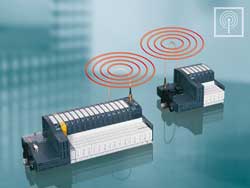
Posted to News on 25th Mar 2008, 21:08
A broad choice of industrial communication technologies
Since Pilz launched SafetyBUS p as the first safe, open fieldbus system in 1999, several other safety fieldbuses have arrived on the scene. Nevertheless, SafetyBUS p is still viewed as one of the most trusted and versatile safety fieldbuses.

One reason behind this is that SafetyBUS p is used alongside other networks so that safety data and non-safety data are not transmitted on the same physical cable. Another is that over 120,000 SafetyBUS p nodes are installed worldwide, handling safety-related data in a diverse range of industries. In machine safety applications SafetyBUS p offers fast reaction times and excellent diagnostics. Alternatively, SafetyBUS p can be used for applications in which a longer reaction time is acceptable but where transmission over longer distances is required - such as cable cars. Elsewhere, SafetyBUS p has been used in projects as diverse as automotive production lines, cyclotrons and steelworks.
High integrity was designed into SafetyBUS p from the outset, so today SafetyBUS p is approved for: Category 4 in accordance with EN 954-1; SIL 3 to IEC 61508; AK 6 (Class 6) of DIN V 19250; and NFPA 79. Put simply, SafetyBUS p can be used in virtually any safety-related or high-integrity application. In addition, SafetyBUS p meets the EMC requirements of the ESPE standard EN 61496-1 and is the first safety-related SEMI standard for sensor bus technology in the semiconductor industry to be incorporated into the E54 suite of standards.
SafetyNET p
Despite the proven versatility of SafetyBUS p, the market is demanding safety-related communications based on standard Ethernet. Pilz has therefore developed SafetyNET p. In fact two speed classes of SafetyNET p have been created: RTFN (real time frame network) for fieldbus class communication and for networking individual production cells with processing cycles of approximately 1ms; and RTFL (real time frame line) for real-time communication in highly dynamic applications where a guaranteed scan time of 62.5us or less is required, such as for high-speed filling and packaging machinery, or where servo drives or robots need to be networked. Both speed classes are compatible with each other and may be used separately or in combination. Users can create linear, star or tree topologies, or any hybrid of these.
Unlike SafetyBUS p, which physically separates the safety data from the non-safety data, with SafetyNET p safety-related data and standard control (non-safety) data are physically mixed but logically separated. When SafetyNET p is implemented, each device has a real-time clock with interrupt function to ensure a rapid reaction to time-critical events. In very fast process cycles and distributed real-time applications, information processing is therefore synchronous, and the system is guaranteed to respond in a precisely definable time (deterministic).
One of the advantages offered by SafetyNET p is exceptional versatility. For example, existing SafetyBUS p installations can co-exist with and be connected to a SafetyNET p network. Moreover, other industrial Ethernet systems such as Profinet, Ethernet/IP and EtherCAT can also be connected to SafetyNET p, as can any Ethernet-compatible device, such as a PC, camera, printer or display. Because SafetyNET p is based on Ethernet, it can also be used as a platform for IP-based utilities such as e-mail, the internet or streaming.
InduraNET p
Between them, SafetyBUS p and SafetyNET p are suitable for a vast array of safety-related applications. In addition, however, Pilz has developed InduraNET p (Industrial Radio Network), a wireless system for non-safety communications in industrial environments.
Anywhere that a cable-based non-safety communication link is difficult, expensive or impractical to install, InduraNET p can help. Typical applications include automated guided vehicles, automated warehousing, robotic palletisers, cranes and other moving machinery.
A key feature of InduraNET p is that the communication technology is especially hardened to ensure reliable communications in industrial environments. In part this is due to an innovative antenna design that guarantees a constant, high-quality connection under all application conditions. InduraNET p also benefits from intelligent frequency management, known as Coexistence Frequency Management (CFM), which means it can co-exist with other wireless services in the 2.4GHz ISM band, with high immunity to interference from services such as DECT, UMTS or GSM.
Initially InduraNET p is available for implementing with a Pilz PSSuniversal I/O and control platform by means of converter modules. One base station can communicate with up to four remote stations, and there is no need for users to be aware of the wireless connection, as the view of the process I/O image remains the same.
Please contact Pilz to request more information by emailing [email protected] or visit www.pilz.co.uk.
Want the latest machine building news straight to your inbox? Become a MachineBuilding member for free today >>

















